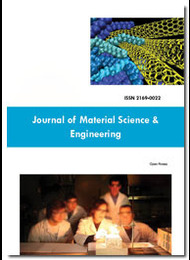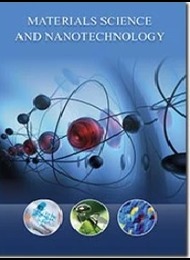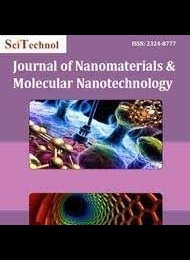Theme:
Smart Materials 2023
We are honoured and delighted to welcome you to the “10th Global Conference on Smart Materials and Nanotechnology” which will be held in Vienna, Austria on July 12-13, 2023
Both an in-person event and an online version of the Smart Materials 2023 are offered. We believe that the decision we made will encourage broad participation.
Smart materials 2023 give chance to grasp the latest advancements, technologies, Nanotechnology methods and its implementation in multidisciplinary subjects such as Material science, Nano electronics, Nano biotechnology, Nano robots and Diagnostic devices.
On behalf of organizing committee here we are happy to invite all speakers, delegates, industrialists, students and young achievers to attend the 10th Global Conference on Smart Materials and Nanotechnology which is going to be held on July 12-13, 2023 |Vienna, Austria with theme Focusing and Expanding the Significant Assessment in Nanotechnology Inventions to the Globe
The "10th Global Conference on Smart Materials and Nanotechnology” aims to bring together leading academic scientists, researchers and research scientists to exchange and share their experiences and findings on all aspects of nanotechnology. It also provides the best interdisciplinary platform for Material science, Nano electronics, Nano biotechnology, Nano robots and Diagnostic devices. health professionals, researchers, practitioners and educators to present and discuss practical challenges and solutions in the areas of the latest innovations, trends, concerns on nanotechnology. The main focus 10th Global Conference on Smart Materials and Nanotechnology of is on the Focusing and Expanding the Significant Assessment in Nanotechnology Inventions to the Globe
Track 1: Smart Materials
Smart Materials are also known as advanced materials or intelligent materials or responsive materials. These materials can be defined as advanced materials that can respond smartly to environmental changes. The general feature of all smart materials is the fact that one or more properties might be significantly altered under controlled conditions by external stimuli such as stress, moisture, electric fields, magnetic fields, light, temperature etc.. This study focuses on Smart Materials types and applications in various fields.
Smart Materials are becoming more popular because they have various applications as compared to standard materials. These special materials can change their properties such as materials which can change its shape just by adding some heat or can change its phase instantly when placed near magnet.
The new era of "smart materials" will have a significant impact on humanity. For instance, some of them can adapt their properties to the environment, while others have sensory capabilities, some can repair themselves automatically, and some can degrade on their own. These extraordinary properties of "smart materials" will have an effect on every facet of civilization.
- Graphene
- Nanoparticle.
- Hydrogel.
- Elastomer
- Metal Organic Framework.
Related Associations and Societies:
The International Association of Nanotechnology (IANT) | The Nanotechnology World Association (NWA) | Indian Association of Nanoscience and Nanotechnology (IANN) | The Nanotechnology Industries Association (NIA) | National Nanofabrication Infrastructure Network (NNIN) | European Nanoscience and Nanotechnology Association (ENNA) | Asian Nanoscience and Nanotechnology Association (ANNA) | Czech Nanotechnology Industries Association
Track 2: Smart Ceramics and Composites
Materials made from ultrafine particles are known as smart ceramics. They are inorganic, non-metallic materials that are shaped and then heated to a high temperature to form nitride or carbide materials, such as clay, that are hard, brittle, heat-resistant, and corrosion-resistant. The preparation, inspection, and evaluation of ceramic microstructures is known as ceramicography. Any ceramic substance's crystalline structure and chemical makeup determine its physical qualities. In structural and building materials as well as textile fabrics, mechanical qualities play a crucial role.
The combining of two materials with various physical and chemical properties results in smart composites. Buildings, bridges, boat hulls, swimming pool panels, racing car bodies, shower stalls, bathtubs, storage tanks, imitation granite, and cultured marble basins and worktops are typically made of composite materials.
- Bioceramics
- bioactive ceramics
- multifunctional nanoceramics
- transparent ceramics
- nanocore shells
Related Associations and Societies:
Nanotechnology World Association | Asian Nanoscience and Nanotechnology Association (ANNA) | Czech Nanotechnology Industries Association | The International Association of Nanotechnology (IANT) | European Nanoscience and Nanotechnology Association (ENNA) | National Nanofabrication Infrastructure Network (NNIN) | The International Association of Nanotechnology (IANT) | Indian Association of Nanoscience and Nanotechnology (IANN)
Track 3: Forensic Nanotechnology
Nano-forensics, a completely new area of forensic science associated with the development of nanosensors, nanotechnical methods for real-time crime scene investigation and terrorist activity investigations, determining the presence of explosive gases, biological agents and residues
Forensic Science is a broad field of subspecialties which use techniques adapted from the natural sciences to obtain criminal or other legal evidence
Nanotechnology is beginning to have an impact on the handling of evidence at crime scenes, its analysis in the laboratory and its presentation in the court room. Application of nanotechnology is likely to enhance the capacity to toxic materials, forensic evidence in tissue, materials and soil
- Explosive residue detection
- Ion beam analysis
- Screening of drug-facilitated crime
- Nano trackers
- DNA analysis
Related Associations and Societies:
The International Association of Nanotechnology (IANT) | The Nanotechnology World Association (NWA) | Indian Association of Nanoscience and Nanotechnology (IANN) | The Nanotechnology Industries Association (NIA) | National Nanofabrication Infrastructure Network (NNIN) | European Nanoscience and Nanotechnology Association (ENNA) | Asian Nanoscience and Nanotechnology Association (ANNA) | Czech Nanotechnology Industries Association
Track 4: Materials Science and Engineering
An international forum for the publication of theoretical and experimental investigations relating to the load-bearing capacity of materials as affected by their fundamental properties, processing background, microstructure, and operational environment is provided by Materials Science and Engineering A. Submissions to Materials Science and Technical A should report changes in mechanical behaviour as well as scientific and/or engineering aspects that affect the microstructure-strength correlations of materials.
- Biomaterials and Tissue Engineering.
- Nuclear Engineering
- Functional Materials and Devices
- Advanced Structural Materials
- Multiscale Materials Modelling.
Related Associations and Societies:
Nanotechnology World Association | Asian Nanoscience and Nanotechnology Association (ANNA) | Czech Nanotechnology Industries Association | The International Association of Nanotechnology (IANT) | European Nanoscience and Nanotechnology Association (ENNA) | National Nanofabrication Infrastructure Network (NNIN) | The International Association of Nanotechnology (IANT) | Indian Association of Nanoscience and Nanotechnology (IANN)
Track 5: Smart Sensors
Smart sensors are tools that use wireless connection and embedded microprocessors to monitor, analyse, and maintain diverse systems. They gather data from the physical environment. They are able to gather environmental data more precisely and with fewer false noise. Despite having a wide range of uses, they are most frequently found in monitoring systems like smart grids, research applications, and security systems.
Smart sensors rely on embedded microprocessors to assist them carry out a variety of tasks, including digital processing, analogue to digital code conversion, interface operations, and computations. In accordance with the information they gather, they also decide when data has to be erased or retained.
To function, they also depend on Micro Electro Mechanical Systems (MEMS) and Very Large Scale Integration (VLSI) technology. The sensor can process massive amounts of data in a split second thanks to MEMS. Additionally, it strengthens and improves the sensor's self-calibration capabilities. The MEMS component VLSI transforms gathered data into electrical signals for processing, display, recording, and transport.
- Humidity sensors
- Motion / occupancy sensors
- Contact sensors
- Gas / air quality sensor
Related Associations and Societies:
The International Association of Nanotechnology (IANT) | The Nanotechnology World Association (NWA) | Indian Association of Nanoscience and Nanotechnology (IANN) | The Nanotechnology Industries Association (NIA) | National Nanofabrication Infrastructure Network (NNIN) | European Nanoscience and Nanotechnology Association (ENNA) | Asian Nanoscience and Nanotechnology Association (ANNA) | Czech Nanotechnology Industries Association
Track 6: Biomarkers
A biological molecule found in blood, other body fluids, or tissues that is a sign of a normal or abnormal process, or of a condition or disease. A biomarker may be used to see how well the body responds to a treatment for a disease or condition. Also called molecular marker and signature molecule.
- Diagnostic biomarker
- Monitoring biomarker
- Predictive biomarker
- Prognostic biomarkers
Related Associations and Societies:
Nanotechnology World Association | Asian Nanoscience and Nanotechnology Association (ANNA) | Czech Nanotechnology Industries Association | The International Association of Nanotechnology (IANT) | European Nanoscience and Nanotechnology Association (ENNA) | National Nanofabrication Infrastructure Network (NNIN) | The International Association of Nanotechnology (IANT) | Indian Association of Nanoscience and Nanotechnology (IANN)
Track 7: Graphene and 2D Materials
Manufacturing and application of two-dimensional materials is a fast expanding area of nanotechnology. Since its discovery in 2004, graphene, one of the first completely 2D materials to be separated, has been dubbed to as the substance of the 21st century due to a combination of its special characteristics and prospective uses. The most noteworthy 2D materials since then have been hexagonal boron nitride (hBN), transition metal dichalcogenides (TMDCs), and MXenes. 2D materials offer a wide range of characteristics. It might not take long for 2D materials to ignite a technological revolution that will fundamentally alter the course of history.
- graphene oxide
- pristine grapheme
- functionalized grapheme
- graphene quantum dot
- reduced graphene oxide.
Related Associations and Societies:
The International Association of Nanotechnology (IANT) | The Nanotechnology World Association (NWA) | Indian Association of Nanoscience and Nanotechnology (IANN) | The Nanotechnology Industries Association (NIA) | National Nanofabrication Infrastructure Network (NNIN) | European Nanoscience and Nanotechnology Association (ENNA) | Asian Nanoscience and Nanotechnology Association (ANNA) | Czech Nanotechnology Industries Association
Track 8: Nanotechnology in Neuroscience and Neuroengineering
The primary goal of neuroengineering is to create artificial systems and brand-new materials that can be physically and functionally interfaced with the main alarming device (CNS). At the point where artificial transducers/actuators interact with resident cells, there is now an anticipation that substance science and nanotechnology will be able to address these issues and result in advances. As a result, nanoparticles can be used to create diagnostic tools as well as nano-enabled shipping systems that can bypass the BBB in order to facilitate both conventional and cutting-edge neurotherapeutic interventions, such as drug therapy, gene therapy, and tissue regeneration. Nanoparticles have the ability to penetrate the BBB of in vitro and in vivo models.
- Magnetic Nanoparticles and Magnetic Tunneling Junctions
- Nano-Electrical and Chemical Stimulation
- Multielectrode Arrays
- Resistive Memory Devices
Related Associations and Societies:
Nanotechnology World Association | Asian Nanoscience and Nanotechnology Association (ANNA) | Czech Nanotechnology Industries Association | The International Association of Nanotechnology (IANT) | European Nanoscience and Nanotechnology Association (ENNA) | National Nanofabrication Infrastructure Network (NNIN) | The International Association of Nanotechnology (IANT) | Indian Association of Nanoscience and Nanotechnology (IANN)
Track 9: Nano Medicine
The field of medicine known as nanomedicine uses nanotechnology's knowledge and tools to prevent and treat disease. In order to diagnose, deliver, sense, or operate upon a living creature, nanomedicine involves the use of tiny materials, such as biocompatible nanoparticles and nanorobots.
- Liposome
- Neoplasm
- Nanoparticle
- Nanocarrier
Related Associations and Societies:
The International Association of Nanotechnology (IANT) | The Nanotechnology World Association (NWA) | Indian Association of Nanoscience and Nanotechnology (IANN) | The Nanotechnology Industries Association (NIA) | National Nanofabrication Infrastructure Network (NNIN) | European Nanoscience and Nanotechnology Association (ENNA) | Asian Nanoscience and Nanotechnology Association (ANNA) | Czech Nanotechnology Industries Association
Track 10: Tissue Engineering
Tissue engineering is the process of mixing scaffolds, cells, and physiologically active chemicals to create functional tissues. It developed from the field of biomaterials development. Creating functional constructions that repair, preserve, or enhance damaged tissues or entire organs is the aim of tissue engineering. Artificial skin and cartilage are two examples of synthetic tissues that have received FDA approval; nevertheless, their use to human patients is currently limited.
- Drug Delivery
- Fabrication.
- Biocompatibility
- Engineering
Related Associations and Societies:
Nanotechnology World Association | Asian Nanoscience and Nanotechnology Association (ANNA) | Czech Nanotechnology Industries Association | The International Association of Nanotechnology (IANT) | European Nanoscience and Nanotechnology Association (ENNA) | National Nanofabrication Infrastructure Network (NNIN) | The International Association of Nanotechnology (IANT) | Indian Association of Nanoscience and Nanotechnology (IANN)
Track 11: Polymers Science & Engineering
Engineering that designs, analyses, and alters polymer materials is often referred to as polymer engineering. Petrochemical industrial features, polymerization, structure and characterization of polymers, properties of polymers, compounding and processing of polymers, descriptions of key polymers, structure-property relations, and applications are all covered by polymer engineering.
- Chemical Engineer
- Research Scientist
- Polymer Engineer
- Sales Engineer
Related Associations and Societies:
The International Association of Nanotechnology (IANT) | The Nanotechnology World Association (NWA) | Indian Association of Nanoscience and Nanotechnology (IANN) | The Nanotechnology Industries Association (NIA) | National Nanofabrication Infrastructure Network (NNIN) | European Nanoscience and Nanotechnology Association (ENNA) | Asian Nanoscience and Nanotechnology Association (ANNA) | Czech Nanotechnology Industries Association
Track 12: Optical & Electronic Smart Materials
both digital and optical Light and energy are connected to and necessary for smart materials. Optics and electronics involve the study, design, and production of intelligent materials that can change electrical signals into light signals and light signals into electrical signals. Devices that convert them are optoelectronic ones. In optoelectronics, the role of light's quantum mechanical effect is growing. Examples of optoelectronic technology include laser systems, remote sensing systems, fibre communications, and electric eyes medical diagnostic systems.
- Piezoelectric materials.
- Shape memory materials.
- Chromoactive materials.
- Magnetorheological materials.
- Photoactive materials
Related Associations and Societies:
Nanotechnology World Association | Asian Nanoscience and Nanotechnology Association (ANNA) | Czech Nanotechnology Industries Association | The International Association of Nanotechnology (IANT) | European Nanoscience and Nanotechnology Association (ENNA) | National Nanofabrication Infrastructure Network (NNIN) | The International Association of Nanotechnology (IANT) | Indian Association of Nanoscience and Nanotechnology (IANN)
Track 13: Memory polymers
Shape memory polymers are an exciting area of polymer innovation. In essence, they are materials that can ‘remember’ what shape they were and return to that shape when some stimulus, like heat or light, is applied.
The range of applications of such materials is huge, covering medical, industrial, electronics, textiles and others, and development across all of these areas is still ongoing in laboratories around the world.
- polytetrafluoroethylene (PFTE)
- polylactide (PLA)
- ethylene-vinyl acetate (EVA)
Related Associations and Societies:
The International Association of Nanotechnology (IANT) | The Nanotechnology World Association (NWA) | Indian Association of Nanoscience and Nanotechnology (IANN) | The Nanotechnology Industries Association (NIA) | National Nanofabrication Infrastructure Network (NNIN) | European Nanoscience and Nanotechnology Association (ENNA) | Asian Nanoscience and Nanotechnology Association (ANNA) | Czech Nanotechnology Industries Association
Track 14: Nano Science Research in Agriculture and Food Science
Nanotechnology, a promising area of study, has welcomed a wide range of opportunities in the last ten years and is anticipated to significantly accelerate technical advancements in a number of industrial sectors in the years to come. Nanotechnology has a huge range of possible advantages and gains. These include nanoporous zeolites for slow release and efficient dose of water and fertiliser, nanocapsules for herbicide delivery and vector and pest management, and nanosensors for pest detection in agricultural productivity enhancement. The manipulation of Nanoparticles is made possible by the atom-by-atom arrangement, which changes their size, shape, and orientation for interaction with the targeted tissues. It is now recognised that many insects contain geomagnetic sensors located in their heads, thoraxes, and abdomens.
- nanoformulations of agrochemicals for applying pesticides and fertilizers for crop improvement
- the application of nanosensors in crop protection for the identification of diseases and residues of agrochemicals
- nanoparticles
Related Associations and Societies:
Nanotechnology World Association | Asian Nanoscience and Nanotechnology Association (ANNA) | Czech Nanotechnology Industries Association | The International Association of Nanotechnology (IANT) | European Nanoscience and Nanotechnology Association (ENNA) | National Nanofabrication Infrastructure Network (NNIN) | The International Association of Nanotechnology (IANT) | Indian Association of Nanoscience and Nanotechnology (IANN)
Track 15: Dentistry Materials
The study of material composition, physical, chemical, and biological qualities as well as how dental materials interact with their oral environments are all covered by the field of dental material science.
Classification of Dentistry Materials
- Preventive dental materials
- Restorative dental materials
- Auxiliary dental materials
Related Associations and Societies:
The International Association of Nanotechnology (IANT) | The Nanotechnology World Association (NWA) | Indian Association of Nanoscience and Nanotechnology (IANN) | The Nanotechnology Industries Association (NIA) | National Nanofabrication Infrastructure Network (NNIN) | European Nanoscience and Nanotechnology Association (ENNA) | Asian Nanoscience and Nanotechnology Association (ANNA) | Czech Nanotechnology Industries Association
Track 16: Energy Saving Materials
Utilizing energy-saving materials and technologies effectively is crucial for lowering building energy consumption, which has significant economic and practical implications for the transition to net zero. Recent years have seen a rise in the popularity of thermal energy storage (TES) materials, photovoltaic (PV) and solar thermal technologies, as well as digital technologies. These advancements have had a significant impact on the design and construction of low-carbon buildings.
- Insulating Concrete Forms
- Straw and Stucco
- Compressed Soil
- Structural Insulated Panels
- Vacuum Insulation Panels
Related Associations and Societies:
Nanotechnology World Association | Asian Nanoscience and Nanotechnology Association (ANNA) | Czech Nanotechnology Industries Association | The International Association of Nanotechnology (IANT) | European Nanoscience and Nanotechnology Association (ENNA) | National Nanofabrication Infrastructure Network (NNIN) | The International Association of Nanotechnology (IANT) | Indian Association of Nanoscience and Nanotechnology (IANN)
Track 17: Protein Based Materials
Due to their structure and biological characteristics, proteins play a crucial part in many natural systems. Proteins have been extensively studied in recent decades due to their distinctive properties, providing a wide range of options for the creation of novel biomaterials, including films, foams, composites, and gels, particularly for biomedical applications like drug delivery systems, biosensors, and scaffolds for tissue regeneration. This review aims to provide a broad overview of the potential of protein-based materials within the context of sustainable polymers, covering topics like protein types, selection/isolation, properties of protein-based (nano)materials, and biomedical applications, as well as material preparation methods.
- Elastin composition
- Resilin composition
- Collagen composition
- Keratin composition
Related Associations and Societies :
The International Association of Nanotechnology (IANT) | The Nanotechnology World Association (NWA) | Indian Association of Nanoscience and Nanotechnology (IANN) | The Nanotechnology Industries Association (NIA) | National Nanofabrication Infrastructure Network (NNIN) | European Nanoscience and Nanotechnology Association (ENNA) | Asian Nanoscience and Nanotechnology Association (ANNA) | Czech Nanotechnology Industries Association
Track 18: Green Nanotchnology
Green nanotechnology refers to the use of nanotechnology to enhance the environmental sustainability of processes producing negative externalities. It also refers to the use of the products of nanotechnology to enhance sustainability. It includes making green nano-products and using nano-products in support of sustainability.
Green nanotechnology has been described as the development of clean technologies, "to minimize potential environmental and human health risks associated with the manufacture and use of nanotechnology products, and to encourage replacement of existing products with new nano-products that are more environmentally friendly throughout their lifecycle
- Solar cells
- Nanoremediation and water treatment
- Environmental remediation
- Water cleaning technology
- Water filtration
Related Associations and Societies:
Nanotechnology World Association | Asian Nanoscience and Nanotechnology Association (ANNA) | Czech Nanotechnology Industries Association | The International Association of Nanotechnology (IANT) | European Nanoscience and Nanotechnology Association (ENNA) | National Nanofabrication Infrastructure Network (NNIN) | The International Association of Nanotechnology (IANT) | Indian Association of Nanoscience and Nanotechnology (IANN)
Track 19: Applications of Material Technology
Smart Materials have the potential to create intelligent materials and structures. the variety of potential products, including those with fresh designs, quality assurance, multifunctionality, security features, and field values that are applied externally, such as stress, temperature, and electric or magnetic fields. Composite materials embedded with fibre optics, actuators, sensors, Micro Electro Mechanical Systems (MEMSs), vibration, sound, and shape control, product health or lifetime monitoring, cure monitoring, intelligent processing, active and passive controls, self-repair (healing), artificial organs, novel indicating devices, designed magnets, damping aero elastic stability, and stress distributions are all part of this process.
Related Associations and Societies:
Nanotechnology World Association | Asian Nanoscience and Nanotechnology Association (ANNA) | Czech Nanotechnology Industries Association | The International Association of Nanotechnology (IANT) | European Nanoscience and Nanotechnology Association (ENNA) | National Nanofabrication Infrastructure Network (NNIN) | The International Association of Nanotechnology (IANT) | Indian Association of Nanoscience and Nanotechnology (IANN)
Track 20: Nanotechnology Applications
Nanoscale additives to or surface treatments of fabrics can provide lightweight ballistic energy deflection in personal body armor, or can help them resist wrinkling, staining, and bacterial growth.
Clear nanoscale films on eyeglasses, computer and camera displays, windows, and other surfaces can make them water- and residue-repellent, antireflective, self-cleaning, resistant to ultraviolet or infrared light, antifog, antimicrobial, scratch-resistant, or electrically conductive.
Lightweighting of cars, trucks, airplanes, boats, and space craft could lead to significant fuel savings. Nanoscale additives in polymer composite materials are being used in baseball bats, tennis rackets, bicycles, motorcycle helmets, automobile parts, luggage, and power tool housings, making them lightweight, stiff, durable, and resilient. Carbon nanotube sheets are now being produced for use in next-generation air vehicles. For example, the combination of light weight and conductivity makes them ideal for applications such as electromagnetic shielding and thermal management.
Nano-engineered materials in automotive products include high-power rechargeable battery systems; thermoelectric materials for temperature control; tires with lower rolling resistance; high-efficiency/low-cost sensors and electronics; thin-film smart solar panels; and fuel additives for cleaner exhaust and extended range.
Related Associations and Societies:
The International Association of Nanotechnology (IANT) | The Nanotechnology World Association (NWA) | Indian Association of Nanoscience and Nanotechnology (IANN) | The Nanotechnology Industries Association (NIA) | National Nanofabrication Infrastructure Network (NNIN) | European Nanoscience and Nanotechnology Association (ENNA) | Asian Nanoscience and Nanotechnology Association (ANNA) | Czech Nanotechnology Industries Association
Market Analysis:
The market for smart materials is estimated to be worth US$47.544 billion in 2019 and is expected to grow at a CAGR of 13.46% to reach US$115.080 billion by 2026. Smart materials have both intrinsic and extrinsic properties and are flexible or cunning. Moisture, temperature, electromagnetic fields, and pressure are a few examples of external stimuli that might alter them and produce the desired functional outcomes. Additionally, these materials are dynamic and change their properties in reaction to the conditions of their direct interaction. Materials that were previously impossible to produce with conventional materials like polymers/plastics, metals, glass, and ceramics can now be produced thanks to advances in materials science.
Demand is anticipated to expand over the coming years as smart actuators and motors, sensors, and structural materials are used more frequently. Additionally, these devices help simplify elderly people's lives by reducing the complexity of their everyday routines. This age group's population share is anticipated to increase significantly in the not-too-distant future, increasing demand for products made of smart materials.
As manufacturing techniques have advanced and better materials have been used, the application of smart materials has increased across a range of end-user industries. The applications of smart materials are anticipated to rise significantly, and they will be crucial to the market's expansion. The impact is therefore anticipated to be substantial during the anticipated time frame. Numerous industrial applications have been realised for materials including piezoelectric, shape memory, electrostrictive, magnetostrictive, phase change, and electrochromic in recent years. In addition, ferromagnetic shape memory alloys, electroactive polymers, conductive polymers, and carbon nanotube actuators are only a few examples of the emerging materials with enormous market potential.
Conference Highlights
To share your views and research, please click here to register for the Conference.
To Collaborate Scientific Professionals around the World
| Conference Date | July 12-13, 2023 | ||
| Sponsors & Exhibitors |
|
||
| Speaker Opportunity Closed | |||
| Poster Opportunity Closed | Click Here to View | ||
Useful Links
Special Issues
All accepted abstracts will be published in respective Our International Journals.
- Journal of Material Sciences & Engineering
- Materials Science and Nanotechnology
- Journal of Nanomaterials & Molecular Nanotechnology
Abstracts will be provided with Digital Object Identifier by









